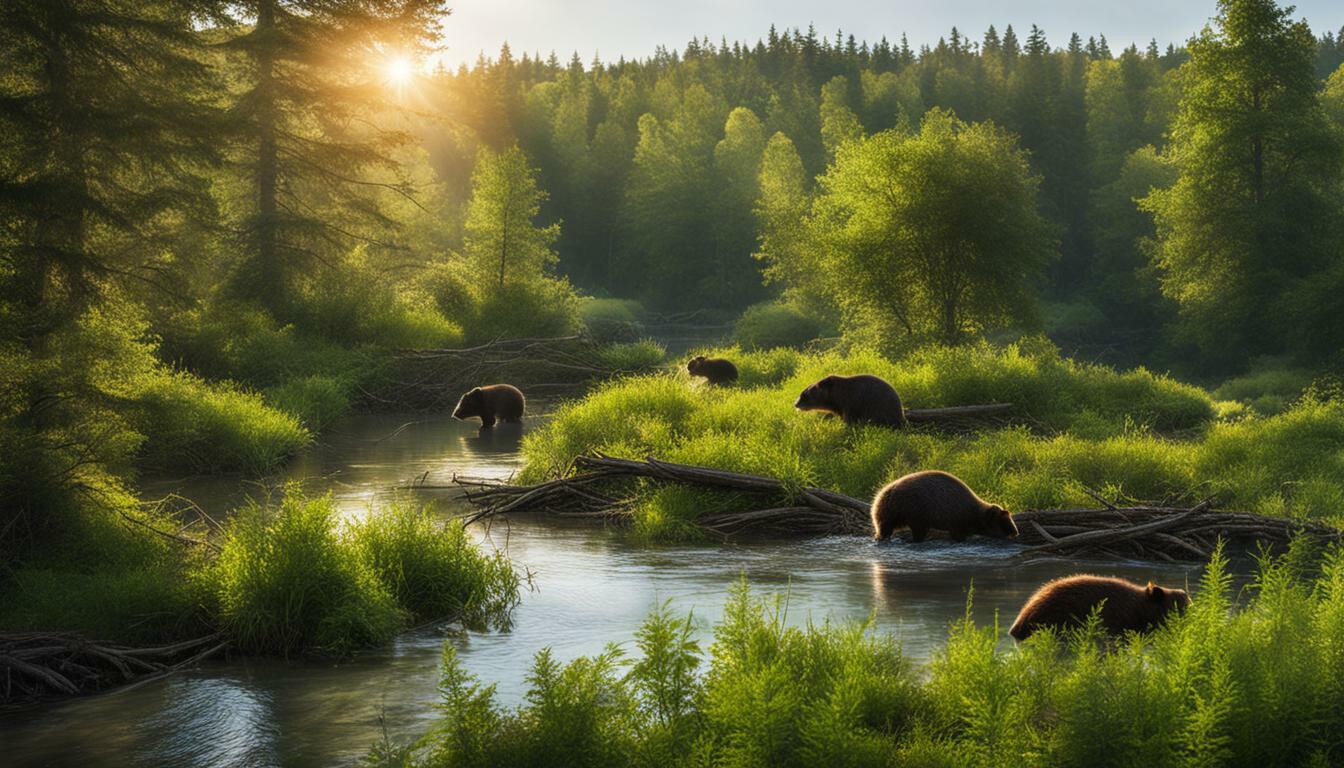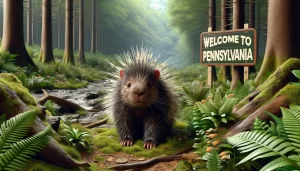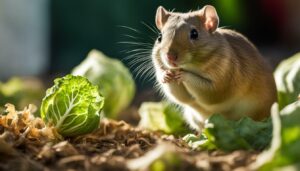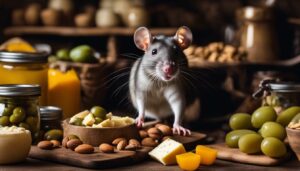Georgia is home to a thriving population of beavers, making it an excellent destination for wildlife enthusiasts and nature lovers. These charming creatures can be found throughout the state, particularly in areas with a year-round water source. While beavers were once eliminated from Georgia and the United States due to unregulated trapping and habitat loss, a restoration program in the 1940s helped bring them back. Today, beavers are abundant in Georgia and play a critical role in the ecosystem as a keystone species.
Key Takeaways:
- Beavers are native to Georgia and can be found in various locations throughout the state.
- They were once eliminated from the area but were successfully restored in the 1940s.
- Beavers are considered a keystone species and play a vital role in the ecosystem.
- They are known for their engineering abilities and can create dams that hold back large amounts of water.
- Beavers can cause issues in urban environments, such as flooding and infrastructure damage, but wildlife management programs help mitigate their impact.
The Restoration of Beavers in Georgia
The beaver population in Georgia has made a remarkable recovery thanks to dedicated conservation efforts. After being eliminated from the state and the United States due to unregulated trapping and habitat loss, a restoration program in the 1940s helped bring them back. Today, beavers can be found throughout Georgia, particularly in areas with a year-round water source.
Beavers play a critical role in the ecosystem as a keystone species. They are known for their engineering abilities, constructing dams and lodges that create important wetland habitats. These structures help control water flow, recharge aquifers, and provide homes for various plant and animal species.
In addition to their impressive construction skills, beavers have a diverse diet that includes bark, aquatic plants, and green shoots. They contribute to the overall health of the environment by promoting the growth of vegetation and creating open water habitats that attract a variety of wildlife.
| Conservation efforts for Georgia beavers: |
|---|
| Wildlife management programs |
| Control of beaver populations |
| Mitigating impact on urban areas |
While beavers are beneficial to the ecosystem, their presence can sometimes cause issues in urban environments. Flooding and damage to infrastructure are common concerns. That’s why wildlife management programs are in place to help control beaver populations and mitigate their impact in urban areas. These programs aim to find a balance between human needs and the conservation of beavers and their habitats.
In conclusion, the restoration of beavers in Georgia is a success story. Through conservation efforts, the beaver population has rebounded, benefiting the ecosystem and contributing to the biodiversity of the state. Ongoing wildlife management programs are vital for maintaining this delicate balance between human activities and the preservation of Georgia’s beaver population.
Beaver Habitats in Georgia
Beavers in Georgia thrive in habitats with ample water sources and vegetation that support their unique needs. These industrious creatures are known for their dam-building skills, and they require a year-round water supply to construct and maintain their aquatic dwellings. Rivers, streams, ponds, and wetlands are all prime locations where beavers can be found in the state.
When it comes to choosing suitable habitats, beavers have a preference for areas with slow-moving or still water. This allows them to construct their dams and create the necessary environment for their lodges. The presence of dense vegetation is also crucial, as beavers rely on woody plants and trees for food and building materials.
Beavers modify their surroundings to their advantage, creating a complex network of dams that help manage water levels to their liking. These structures not only create suitable habitats for themselves but also have far-reaching impacts on the ecosystem. Beaver dams help regulate water flow, control erosion, and provide valuable habitat for other aquatic species.
| Characteristics of Beaver Habitats in Georgia | Significance |
|---|---|
| Year-round water sources | Essential for beavers’ survival and dam-building activities |
| Dense vegetation | Provides food and building materials for beavers |
| Presence of suitable tree species | Allows beavers to gnaw and use wood for constructing dams and lodges |
Protecting Beaver Habitats in Georgia
Preserving the integrity of beaver habitats is crucial for the long-term conservation of these fascinating creatures. Efforts are underway to protect and manage these habitats, ensuring the sustainability of beaver populations in Georgia. This includes implementing measures to maintain water quality, conserving riparian vegetation, and minimizing disturbances that could disrupt beaver activities.
Conservation organizations and wildlife agencies work collaboratively to raise awareness about the importance of protecting beaver habitats. They engage in community outreach programs, providing education on the benefits of coexisting with beavers and implementing strategies to prevent conflicts between beavers and human activities, particularly in urban areas.
By understanding and respecting the needs of beavers and their habitats, we can ensure their continued presence in Georgia’s natural landscape. Conservation efforts play a vital role in maintaining the delicate balance of the ecosystem and preserving the rich biodiversity that these industrious mammals contribute to.
Behavior of Georgia Beavers
Georgia beavers exhibit fascinating behavior, including their remarkable engineering skills and their wide-ranging diet. These aquatic mammals are known for their ability to construct complex dams and lodges, altering the landscape to create ideal habitats for themselves and other wildlife. Beavers in Georgia are expert builders, using logs and branches to create sturdy dams that can hold back large amounts of water. These dams serve multiple purposes, including providing a stable environment for the beavers to live in and raising the water levels in surrounding areas, which helps create wetlands and supports a diverse range of plant and animal species.
In addition to their engineering prowess, beavers in Georgia have a diverse diet that includes bark, aquatic plants, and green shoots. They are herbivores and feed on a variety of vegetation found in and around water bodies. Beavers are known to fell trees using their powerful incisors, allowing them to access the inner bark, which is a crucial part of their diet. They also build feeding platforms near the water’s edge, where they can enjoy a meal while staying safe from potential predators. This adaptable diet allows them to survive and thrive in different habitats across Georgia.
Beavers play a vital role in shaping the ecosystem of Georgia. Their dams create slow-moving, nutrient-rich water bodies that support a wide range of aquatic life, including fish, amphibians, and insects. These dams also help regulate water flow and can be beneficial in preventing erosion and minimizing flood risks. Furthermore, the wetlands created by beavers offer valuable habitat for numerous species of birds, mammals, and reptiles, contributing to the overall biodiversity of Georgia’s ecosystems.
| Notable Behaviors of Georgia Beavers |
|---|
| Engineering skills include building dams and lodges |
| Diverse diet consisting of bark, aquatic plants, and green shoots |
| Creation of wetlands and enhancement of biodiversity |
Beavers and Urban Environments
While beavers are an integral part of Georgia’s ecosystem, their presence in urban environments can sometimes lead to challenges and conflicts. These industrious creatures are known for their dam-building abilities, which can result in flooding and damage to infrastructure in suburban and urban areas. However, with the right knowledge and understanding, coexistence with beavers can be achieved.
To spot beavers in Georgia’s urban environments, keep an eye out for signs of their activity. Look for dams, lodges, and gnawed trees along water bodies, as these are tell-tale signs of beaver presence. Beavers are most active during dawn and dusk, so these are the best times to catch a glimpse of them.
If you encounter a beaver in a suburban or urban setting, it’s important to remember that they are generally shy creatures and will likely not pose a threat. However, it’s best to observe them from a distance and avoid approaching them, especially if they have kits with them. Beavers are protected wildlife in Georgia, and it is illegal to harm or harass them.
| Tips for Coexisting with Beavers in Urban Environments |
|---|
| 1. Install protective measures: If you have valuable trees or landscaping near water bodies, consider installing wire mesh or hardware cloth around the trunks to prevent beavers from gnawing on them. |
| 2. Manage water flow: If beaver dams are causing flooding issues, consult with local authorities or wildlife management professionals to develop a plan for managing water flow in a way that balances human needs and beaver conservation. |
| 3. Educate and raise awareness: Promote public awareness about the importance of beavers in the ecosystem and the need for their conservation. Encourage neighbors and community members to learn about beaver behavior and the benefits they provide to habitats. |
| 4. Seek professional assistance: If beavers are causing significant damage or posing a threat to property, consult with wildlife management professionals for guidance on non-lethal methods to control beaver populations and protect critical habitats. |
By taking these measures and fostering coexistence, we can appreciate and respect the role beavers play in Georgia’s ecosystem while finding sustainable solutions to minimize conflicts in urban environments.
Wildlife Management Programs for Beavers in Georgia
Georgia has implemented wildlife management programs to strike a balance between the needs of beavers and the concerns of urban communities. These programs aim to control beaver populations and mitigate the potential negative impacts caused by their presence in urban environments.
One of the primary goals of these programs is to protect critical habitats for beavers while minimizing conflicts with human activities. Non-lethal methods are often preferred and encouraged, such as the installation of flow devices to regulate water levels and prevent flooding. By managing the water flow, these devices can help to control the size and location of beaver dams, reducing the risk of damage to infrastructure.
Additionally, these wildlife management programs involve educating the public about beavers and their behavior. This helps foster understanding and appreciation for these valuable creatures and encourages a more harmonious coexistence between humans and wildlife. By raising awareness about the important role beavers play in the ecosystem, communities can find sustainable ways to manage conflicts and protect both beavers and their habitats for future generations.
Table: Examples of Wildlife Management Strategies
| Strategy | Description |
|---|---|
| Flow devices | Installation of devices to control water levels and prevent flooding caused by beaver dams. |
| Beaver relocation | Translocating beavers to suitable habitats away from urban areas to reduce conflicts. |
| Habitat modification | Implementing measures to discourage beavers from colonizing certain areas, such as installing barriers or fencing. |
| Public education | Providing information and resources to increase public understanding and promote coexistence with beavers. |
In conclusion, wildlife management programs in Georgia play a crucial role in maintaining a healthy balance between beavers and urban communities. These programs focus on protecting beaver habitats, managing beaver populations, and educating the public. By implementing non-lethal strategies and promoting coexistence, Georgia can ensure the long-term conservation of beavers while addressing the concerns of urban environments.
Spotting Beavers in Georgia
Spotting beavers in Georgia can be an exciting adventure. Here are some helpful tips to increase your chances of seeing these fascinating creatures.
- Look for signs of beaver activity: Beavers are known for their impressive dam-building skills. Look for dams, lodges, and gnawed trees along rivers, streams, and ponds. These structures are clear indications that beavers are present in the area.
- Time your visit wisely: Beavers are most active during dawn and dusk, so plan your outing accordingly. These twilight hours offer the best opportunity to catch a glimpse of these nocturnal animals as they emerge from their lodges to feed.
- Explore suitable habitats: Beavers prefer areas with a year-round water source and an abundance of vegetation. Wetlands, marshes, and slow-moving rivers are prime locations to search for beavers in Georgia.
- Be patient and quiet: Beavers are shy creatures and easily startled by human activity. Move slowly and quietly, minimizing noise and sudden movements. Find a comfortable spot near a beaver habitat, and allow yourself some time to observe their behavior.
Table: Signs of Beaver Activity
| Signs | Description |
|---|---|
| Dams | Large structures built by beavers using tree branches, logs, and mud to create barriers in waterways. |
| Lodges | Mounds of sticks and mud built by beavers as their homes. These lodges typically have underwater entrances. |
| Gnawed Trees | Trees with distinctive marks from beavers’ sharp incisors. Beavers gnaw on trees for food and to construct their dams and lodges. |
By following these tips and keeping a keen eye out for signs of beaver activity, you’ll have a better chance of spotting these incredible creatures in their natural habitat. Remember to respect their space and observe from a safe distance, allowing them to go about their daily routines undisturbed.
The Role of Beavers in the Ecosystem
Beavers in Georgia are more than just charming creatures; they are essential contributors to the overall health and balance of the ecosystem. With their remarkable engineering abilities and distinct behaviors, beavers play a crucial role in shaping the environment they inhabit. Let’s explore the important role they play and the conservation efforts in place to protect these fascinating creatures.
One of the most remarkable aspects of beaver behavior in Georgia is their ability to build dams. These dams not only provide shelter for beavers but also serve a vital purpose in creating wetlands. Wetlands are highly valuable ecosystems that support a diverse range of plants and animals, including migratory birds, amphibians, and fish. By creating dams, beavers help to regulate water flow, improve water quality, and create habitats for countless species.
In addition to their dam-building capabilities, beavers also have a significant impact on the surrounding vegetation. Their diet consists of bark, aquatic plants, and green shoots, which they expertly forage for. By selectively cutting down trees and shrubs, beavers contribute to the rejuvenation and renewal of forests and wetlands. Their activities help to maintain a healthy and dynamic landscape, promoting biodiversity and supporting the overall functioning of the ecosystem.
| Key Points: |
|---|
| Beavers create wetlands through dam-building, providing critical habitats for numerous species. |
| Their selective tree-cutting contributes to forest rejuvenation and promotes biodiversity. |
| By regulating water flow and improving water quality, beavers contribute to a balanced ecosystem. |
Conservation efforts for Georgia beavers aim to protect their habitats and ensure their long-term survival. These efforts involve raising public awareness about the importance of beavers and their positive impact on the environment. It also includes implementing wildlife management programs to balance human needs with beaver conservation, such as non-lethal methods for controlling beaver populations and protecting critical habitats. By safeguarding beavers and their habitats, we can preserve the health of Georgia’s ecosystems for future generations.
The Future of Georgia’s Beavers
With continued conservation efforts and public support, the future of beavers in Georgia looks promising and secure. These remarkable creatures, once on the brink of extinction in the state, have made a remarkable comeback thanks to dedicated restoration programs and increased awareness of their importance in the ecosystem.
Beavers play a critical role in shaping Georgia’s water systems and maintaining the delicate balance of its habitats. Their ability to build dams and create wetlands not only provides them with a suitable habitat but also benefits numerous other species by creating new ecosystems, improving water quality, and preventing erosion. Conserving beavers and their habitats is essential for maintaining the health and biodiversity of Georgia’s natural landscape.
Efforts to protect beavers in Georgia include wildlife management programs that aim to minimize conflicts between humans and beavers. These programs focus on strategies such as non-lethal methods for managing beaver populations and implementing measures to protect critical habitats. By finding sustainable solutions and promoting coexistence, we can ensure that humans and beavers can thrive together.
| Conservation Efforts for Georgia Beavers |
|---|
| Restoration programs |
| Wildlife management programs |
| Habitat protection and preservation |
| Public awareness and education |
| Responsible wildlife management practices |
By supporting these conservation efforts, you are contributing to the long-term survival and well-being of beavers in Georgia. Whether it’s raising awareness about the importance of beavers in the ecosystem, participating in local conservation initiatives, or supporting organizations dedicated to beaver conservation, every action counts. Together, we can ensure that future generations will continue to marvel at the ingenuity and ecological significance of these fascinating creatures in the beautiful state of Georgia.
Balancing Human Needs with Beaver Conservation
Achieving a harmonious coexistence between humans and beavers in Georgia requires thoughtful consideration and a commitment to sustainable solutions. As these fascinating creatures continue to thrive in our state, it is important to protect their habitats while addressing any conflicts that may arise with human activities.
One key aspect of protecting beaver habitats in Georgia is implementing non-lethal methods for controlling beaver populations. This approach focuses on managing beaver behavior and minimizing potential damage without resorting to lethal measures. By employing techniques such as flow devices and fencing, we can create effective barriers that discourage beavers from accessing sensitive areas while preserving their natural habitats.
Protecting critical habitats is also essential for maintaining healthy beaver populations in Georgia. By identifying and conserving areas with suitable water sources and vegetation, we can ensure that beavers have the resources they need to thrive. This includes safeguarding wetlands, streams, and riparian zones, which serve as vital habitat for beavers and a diverse array of wildlife.
| Strategies for Balancing Human Needs with Beaver Conservation | Benefits |
|---|---|
| Implement non-lethal methods for controlling beaver populations | Preserves beavers and their habitats while minimizing conflicts with humans |
| Protect critical habitats such as wetlands and riparian zones | Maintains healthy beaver populations and supports a diverse array of wildlife |
| Educate the public about beaver behavior and conservation | Fosters understanding and appreciation for these remarkable creatures and their role in the ecosystem |
Educating the public about beaver behavior and conservation is another crucial step in achieving this balance. By raising awareness about the important role beavers play in shaping our ecosystem and the challenges they face, we can foster understanding and promote a sense of stewardship towards these remarkable creatures. This includes providing information on how to coexist with beavers in urban environments and reporting any issues to the appropriate wildlife management authorities.
By combining these strategies and engaging in ongoing dialogue between stakeholders, we can create a sustainable framework for beaver conservation in Georgia. It is our responsibility to protect these valuable creatures and their habitats, while also addressing the needs and concerns of our communities. Together, we can ensure a future where beavers thrive alongside humans, contributing to the beauty and vitality of our natural environment.
Conclusion
Beavers in Georgia are not just fascinating creatures; they are an integral part of the state’s ecosystem and deserve our attention and protection. Once eliminated from the state and the entire United States due to unregulated trapping and habitat loss, beavers have made a remarkable comeback thanks to a restoration program in the 1940s. Today, they can be found throughout Georgia, particularly in areas with a year-round water source.
These industrious animals play a vital role as a keystone species, shaping the ecosystem in ways that benefit numerous other species. Beavers are known for their engineering prowess, constructing dams and lodges that create habitats for a variety of aquatic plants and animals. Their diet consisting of bark, aquatic plants, and green shoots further contributes to the health and diversity of their surroundings.
While beavers offer numerous benefits to the ecosystem, their presence can sometimes create challenges in urban environments. Flooding and damage to infrastructure are potential issues that arise when beavers venture into these areas. To address these concerns, wildlife management programs have been implemented in Georgia to control beaver populations and find sustainable solutions to conflicts between beavers and human activities.
It is crucial for us to strike a balance between our needs and the conservation of beavers and their habitats. By appreciating the vital role that beavers play in Georgia’s rich natural heritage, we can work towards coexistence and ensure their long-term survival. Through public awareness, habitat protection, and responsible wildlife management practices, we can protect these remarkable creatures and continue to benefit from the valuable services they provide to our ecosystem.
FAQ
Are beavers present in Georgia?
Yes, beavers are present in Georgia and can be found throughout the state.
Were beavers once eliminated from Georgia?
Yes, beavers were once eliminated from Georgia and the United States due to unregulated trapping and habitat loss.
How were beavers restored in Georgia?
A restoration program in the 1940s helped bring beavers back to Georgia.
Where can beavers be found in Georgia?
Beavers can be found throughout Georgia, particularly in areas with a year-round water source.
What do beavers eat?
Beavers have a diverse diet that includes bark, aquatic plants, and green shoots.
What role do beavers play in the ecosystem?
Beavers are considered a keystone species that plays a critical role in shaping the ecosystem by building dams and lodges.
Can beavers cause issues in urban environments?
Yes, beavers in urban environments can cause issues such as flooding and damage to infrastructure.
Are there wildlife management programs in place to control beaver populations in Georgia?
Yes, there are wildlife management programs in place to help control beaver populations and mitigate their impact.
How can I spot beavers in Georgia?
Look for signs such as dams, lodges, and gnawed trees. Beavers are most active during early mornings and evenings.
What is the future of Georgia’s beavers?
Conservation efforts are ongoing to ensure the long-term survival of Georgia’s beavers and their habitats.
How can we balance human needs with beaver conservation in Georgia?
Balancing human needs and beaver conservation involves implementing non-lethal methods for controlling beaver populations and protecting critical habitats.




